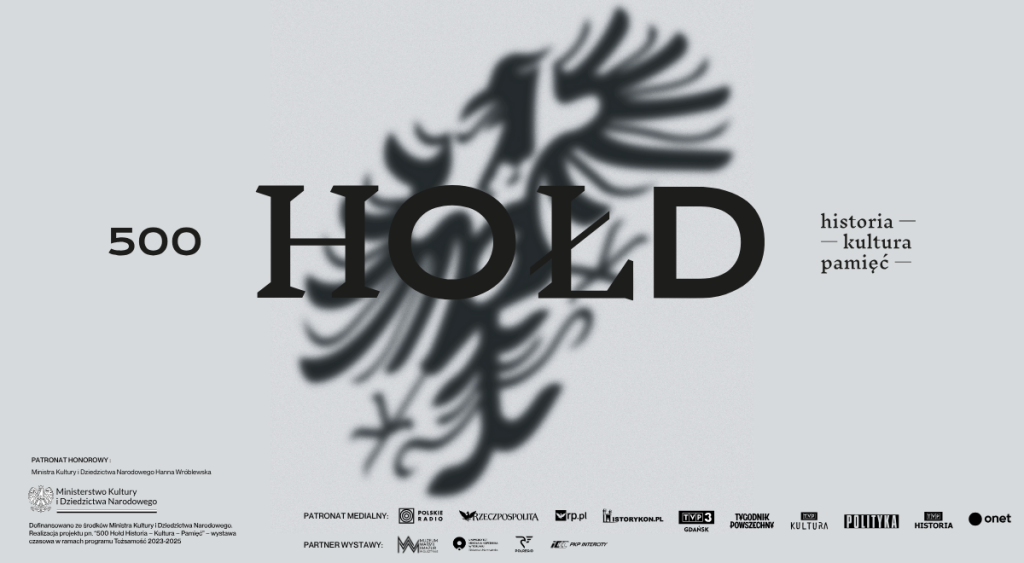„HOMAGE 500. History– Culture – Remembrance” – anniversary exhibition
Five hundred years ago – on 8 April 2025 – the Treaty of Kraków was signed, resulting in the secularisation of the Teutonic Order state in Prussia. The famous ‘Prussian Homage’ took place two days later, on 10 April in Krakow’s Main Market Square. Albrecht Hohenzollern, the last Grand Master of the Teutonic Order in Prussia, pledged allegiance to the Polish king Sigismund I the Old. The state of the Teutonic Order became a fief of the Polish Crown and was since then called Ducal Prussia or the Duchy of Prussia.

500 years of Prussian Homage
About the exhibition
To mark the 500th anniversary of the signing of the Treaty of Kraków and the Prussian Homage,
the Malbork Castle Museum organises the main anniversary exhibition ‘Homage 500. History – Culture – Remembrance’, centred around the events of 1525.
The Malbork Castle, a place of great significance for the Prussian Homage and its consequences, is to become a space for the exchange of ideas, historical debate and educational activities related to this event in 2025.
The exhibition can be visited from 8 April to 29 June 2025 in the Palace of the Grand Masters, the former residence of the Grand Masters of the Order and the kings of Poland, and in the most representative interior – the Great Refectory of the Castle Museum.
The exhibition is divided into three modules:
- HISTORY, telling the story of the troubled relations between the Teutonic Order and Poland and of the prominent figures who brought about the peaceful dissolution and transformation of the monastic state into a secular one, the first Lutheran state in the world, as well as
highlighting the implications of this event for science, literature, culture and politics in Central Europe up to the end of the 18th century; - CULTURE, artistic one, providing an overview of the art, culture and science of the Renaissance court of Königsberg and its links with other European courts, something that will be done for the first time in a museum setting;
- REMEMBRANCE, cultures of memory from the late 18th century to the present day, in the visions of such historians and Polish artists as Marcello Bacciarelli, Jan Matejko, Tadeusz Kantor and Edward Dwurnik.
HISTORY
Before the homage
Nothing in 1519 indicated that the Grand Master of the Teutonic Order, Albrecht Hohenzollern, would bow to his uncle, Sigismund I the Old, King of Poland. Trusting in the support of the Holy Roman Emperor, the Duke attempted to use military force to overturn the provisions of the Second Peace of Thorn (the last war between Poland and the Teutonic Knights, 1519-1521). However,
in the face of military defeats, increasing external pressure, mounting debts to hired troops and strong opposition from the Prussian states, Albrecht signed a four-year truce with the Kingdom of Poland on 5 April 1521. This period of time gave both sides a break and, as it turned out, ushered in a new reality at the beginning of 1525. Sigismund I took advantage of this time and entered into a number of alliances with neighbouring states. Albrecht, unlike the Polish king, struggled with numerous problems. The gradual decline of the Order was accompanied by a lack of support
from the Holy Roman Empire and the increasing influence of the Reformation. The latter was particularly popular as Albrecht had lost his warrior spirit and was now seriously considering the secularisation of the Order under the influence of Martin Luther’s sermons. The negotiations, initiated with King Sigismund I of Poland, were finalised on 8 April 1525 with the signing of a peace treaty by both parties, known as the Treaty of Kraków.
The significance of this event required an additional and spectacular feudal ceremony, which took place on Monday, 10 April 1525 and is known as the ‘Prussian Homage’.
Homage
On that day, at around 10 a.m., the royal procession left Wawel Castle on horseback and travelled to the town hall, in which the king was dressed in a coat and given a crown. He then left the town hall in the company of councillors and travelled to a specially prepared, richly decorated podium located on the main market square next to the town hall. The king was accompanied by the young 5-year-old Prince Augustus, John Statilius (the Hungarian king’s envoy), nine bishops, governors, castellan, Prussian councillors from Toruń and Elbląg, and 2,000 armed men with rifles, spears and halberds stood guard around the barriers.
Shortly before 11 a.m., Albrecht’s emissaries arrived at the place, including Erhard von Queis, Bishop of Pomesania from Kwidzyn He was the first to speak and, paying his respects to the king, he asked on behalf of the margrave to be granted a fiefdom.
Albrecht’s counsellors then went to get the Duke, who arrived in an armour,
accompanied by his brother George and Frederick, Duke of Legnica. After climbing the podium, the three of them knelt down, and Albrecht, who was closer to the king, took a solemn oath by placing two fingers on the Gospel resting on the king’s knees. The oath was followed by a symbolic ceremony of knighting Albrecht, and then the awarding of a white damask banner, which had a black eagle with golden claws, a golden crown around its neck, golden stripes on its wings and a silver letter S on its chest, together with placing a golden chain around the Duke’s neck, worth 600 guilders!
This ceremony was followed by the knighting of other men from Prussia and Poland.
Then, all participants of the Krakow ceremony travelled on horseback to the Church of St Stanislaus, where the hymn Te Deum laudamus [O God, we praise you] was sung, and then to Wawel, where the king hosted a sumptuous reception, bestowing precious gifts on his guests.
To ensure that the homage would not be questioned, it was confirmed on the same day by what was known as a feudal document. This was supposed to protect the new Prussian Duke from possible accusations of unlawful seizure of power.
After the homage
The feudal homage was repeated after Albrecht Hohenzollern returned to Königsberg. This time, the subjects paid homage to the new Prussian Duke. In May 1525, the Königsberg Castle witnessed the reading of the Treaty of Kraków and the swearing of the new treaty by the assembled estates. In return, the Duke released his subjects from all personal liabilities towards the Order.
The Teutonic Order in Prussia had 57 knights at the time. This number alone shows how far the decline had already progressed. Seven of them refused to take the oath, but after several days of negotiations, only one of them, Duke Eric of Brunswick, ended up leaving for the Holy Roman Empire.
The process of transforming the Teutonic Order into the Duchy of Prussia, which was a fiefdom of the Kingdom of Poland, took several months. Albrecht travelled through his duchy to receive the feudal homage of all the estates under his rule. The events in Kraków were legally confirmed by a document issued by the crown chancellery in Kraków in May 1526.
Due to the Reformation gaining popularity in the Holy Roman Empire, the newly appointed Duke of Prussia soon converted to Protestantism. On 6 July, he ordered the ‘preaching of the pure word of God’ in his country, and on 10 December, the Reformation was officially imposed in all of the Duchy of Prussia. This resulted in the creation of the first Lutheran state in Europe.
ABOUT THE CONFERENCE
The exhibition accompanies the international academic conference ‘Prussian Homage (1525-2025): Genesis, Circumstances and Consequences’, taking place at the Museum of Warmia and Mazury in Olsztyn and the Malbork Castle Museum between 12 and 14 May 2025.
SYMBOLISM
‘(…) I do promise and swear that I shall be faithful and true to His Most Excellent Majesty, Lord Sigismund, King of Poland, Grand Duke of Lithuania, Ruthenia, and all the Prussian territories, Lord and Heir, as my rightful hereditary lord, and to the children and successors of His Royal Highness, the kings and the Kingdom of Poland (…)’ – these are the words of the oath taken by the Grand Master Albrecht Hohenzollern.
As a sign of his vassalage to the Polish Crown, Albrecht received a banner
with a black eagle with a golden crown around its neck and a silver letter ‘S’ on its chest, symbolising his vassalage and the name of his liege lord ‘Sigismundus’.
The Treaty of Kraków had to include this important appendix – the public oath ceremony. The acts of homage previously made as part of the Second Peace of Thorn took place within the castle walls. This one, as particularly important because it transformed the Teutonic Order into the Duchy of Prussia, a subject of the Kingdom of Poland, had to be made publicly known. No longer the closed chambers but the heart of the Crown – the Krakow’s Main Market Square and its richly decorated pedestal became the stage from which a clear message was sent: the Teutonic Order in Prussia ceases to exist, and its master, as a secular prince, becomes a vassal of the king!
This scene and its meaning are the topic of castle museum lessons and an open scholarly discussion planned for 2025 at the Castle Museum.
THIS SPRING
This symbolic eagle is the graphic theme of the exhibition, which we are going to use to promote it. We plan to post about the exhibition and the events surrounding it on the castle’s social media, and you can find all of this information by using the hashtag #Hołd500.
We are going to tell the history and interesting facts about the Prussian Homage in the #ocoHOŁDzi series, published every Tuesday on the Castle Museum’s profiles on Facebook and Instagram.
Don’t forget to check out the numerous interviews, articles and podcasts, as we are going to talk about the historic Homage and our exhibition all spring long.
Organizor:
Muzeum Zamkowe w Malborku

Honorary Patronage:
Ministra Kultury i Dziedzictwa Narodowego Hanna Wróblewska

Honorary Committee:


– Aleksander Miszalski, Prezydent Miasta Krakowa

– Profesor dr. dr. h.c. mult. Udo Arnold
– Grand Master Frank Bayard
– Jan Strawiński, Prezydent Stowarzyszenia Konsulów Honorowych w Polsce
Exhibition Partners:





Media Patronage:










Funded by the Ministry of Culture and National Heritage.
Tickets
Buy tickets online
Opening Hours
- Mon:9:00 - 15:00
Exhibitions
- Tue - Sun:9:00 - 15:00
Contact
Tourist Information
- +48 55 647 08 00
- +48 55 647 09 02
- +48 55 647 09 78
